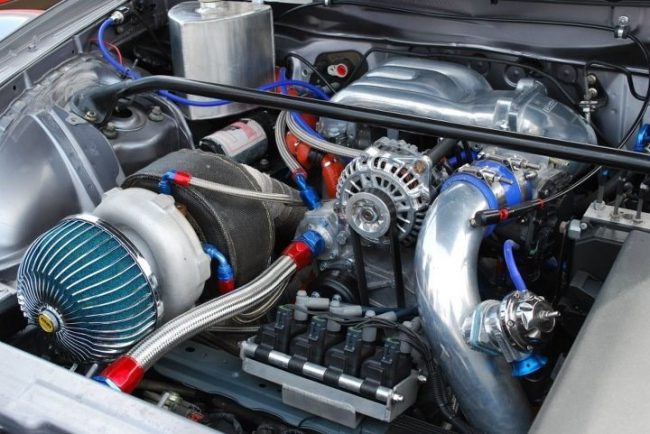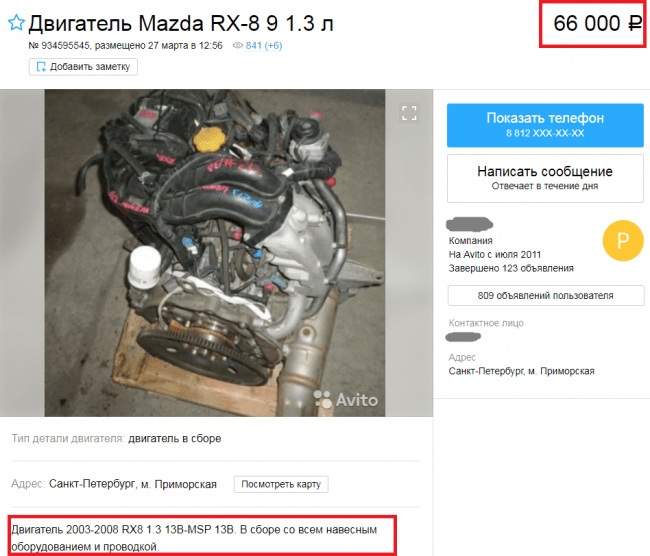
Mazda 13B engine
Content
Mazda 13B rotary engines are power units developed in the early 1960s. Created by Felix Wankel. The developments of the German engineer became the basis for the emergence of a whole family of engines. During the modernization, the engines received turbocharging and an increased engine size.
The 13V engine was built with an emphasis on environmental friendliness. The emission level is much lower than that of analogues. The first parties bore the name AR. The AP motor was used in the assembly of cars from 1973 to 1980.
13V is the most massive engine of its family. Collected for three decades. Served as the basis for all subsequent internal combustion engines. It is not similar to 13A, but is an extended version of 12A. The motor is distinguished by an increased rotor thickness (80 mm) and an engine displacement (1,3 liters).
13V ICE vehicles were commercially available in the United States between 1974 and 1978. They were installed as a power unit for sedans. The latest model on which they meet is the Mazda RX-7. In 1995, cars with ICE 13V disappeared from the US car market. In the Japanese islands, the engine became widespread in 1972. Popularity continued through 2002. The latest model with the unit is the Mazda RX-7.
The next version of the motor that saw the light of day is 13B-RESI. It is distinguished by the presence of an improved intake manifold, the installation of which led to an increase in engine power (135 hp). 13B-DEI has a variable intake system. Four injectors are equipped with an electronic fuel injection system. A supercharger and 13 injectors were installed on 4V-T (atmospheric internal combustion engine).
The 13B-RE differed from the REW version in an interesting combination of turbines that were switched on in series. The first, larger one starts first. After that, if necessary, the second small turbine starts to pump. In turn, 13B-REW is a combination of light weight and power. Turbines of the same size are switched on in a similar REW sequential order. Interestingly, this unit is the first mass-produced engine equipped with sequential turbines.
In general terms, it is worth emphasizing that the engine has gained great fame. The Wankel motor impresses with its unusual design. Inexperienced motorists can also be surprised by the small size of the internal combustion engine, which, with everything else, produces up to 300 horsepower. The engine is slightly larger than the gearbox. Only the Mazda concern decided on the mass production of rotary units. For its time, the motor was innovative, since it did not have a gas distribution system.
Technical specifications
13V
| Volume | 1308 cc |
|---|---|
| Power | 180-250 h.p. |
| Compression ratio | 9 |
| Supercharger | Twin turbo |
| Max. power | 180 (132) hp (kW)/ at 6500 rpm 185 (136) hp (kW)/at 6500 rpm 205 (151) hp (kW)/at 6500 rpm |
| Fuel/consumption | AI-92, 95/6,9-7,2 l/100 km |
| Max. torque | 245 (25) N/m/at 3500 rpm |
| 270 (28) N/m/at 3500 rpm |
| Engine | Volume, cc | Power, hp | Compression ratio | Supercharger | Max. power, hp (kW)/rpm | Fuel/consumption per l/100km | Max. torque, N/m/at rpm |
|---|---|---|---|---|---|---|---|
| 13B-REW | 1308 | 255-280 | 9 | Twin turbo | 280 (206) / 6500 265 (195) / 6500 255 (188) / 6500 | AI-98/6,9-13,9 l | 314 (32) / 5000 |
| 13B-SME | 1308 | 192-250 | 10 | No | 192 (141) / 7000 210 (154) / 7200 215 (158) / 7450 231 (170) / 8200 235 (173) / 8200 250 (184) / 8500 | AI-98/10,6-11,5 | 222 (23) / 5000 |
| 13B-RE | 1308 | 230 | Twin turbo | 230 (169) / 6500 | AI-98, 95/6,9 | 294 (30) / 3500 | |
| 13V | 1308 | 180-250 | 9 | Twin turbo | 180 (132) / 6500 185 (136) / 6500 205 (151) / 6500 | AI-92, 95/6,9-7,2 | 245 (25) / 3500 |
The engine number is located under the alternator. Embossed on cast iron. To see the alphanumeric designation, you need to bend over and look vertically down under the generator. The number may be missing altogether due to the replacement of the front cover.
Pros and cons, maintainability, features
Innovative for its time, the engine boasts not only small dimensions, but also many advantages. First of all, it is worth highlighting the high specific power. It is achieved due to the fact that the mass of moving parts is less than in piston engines. Another plus is excellent dynamics. The car in which this rotor is installed can easily accelerate to 100 km / h.
The benefits also include a high level of efficiency. One cylinder delivers power for ¾ of each revolution of the output shaft. By comparison, a conventional engine piston delivers power for ¼ of a shaft revolution. Complements the list of advantages - a low level of vibration.
As for the shortcomings, the Mazda 13V internal combustion engine is very demanding on fuel.
Pouring low-quality gasoline will not work, which is especially important for Russia. In addition, the power unit is characterized by high oil consumption. For 1000 km it is able to spend 1 liter of liquid. Therefore, it is necessary to monitor the oil level constantly. An oil change is necessary every 5 thousand kilometers.
Spare parts for the engine are expensive, and therefore the service is not available to every motorist. Making spare parts to order is difficult and not every master undertakes it. The engine overheats periodically and is not durable. Theoretically, the motor is able to cover a maximum of 250 thousand kilometers. In practice, such a run practically does not occur.
Models of cars on which engines were installed (only Mazda cars, only gasoline engine)
| Car model | Engine | Years of issue | Power / Gearbox type |
|---|---|---|---|
| Cloud RX-7 | 13B-REW (1.3L, petrol, rear wheel drive) | 1996-97 | 255 hp, automatic 265 hp, manual |
| Cloud RX-7 | 13B-REW (1.3L, petrol, rear wheel drive) | 1991-95 | 255 hp, manual 255 hp, automatic |
| RX-7 | 13B-REW (1.3L, petrol, rear wheel drive) | 1999-02 | 255 hp, automatic 265 hp, manual 280 hp, manual |
| RX-7 | 13B-REW (1.3L, petrol, rear wheel drive) | 1997-98 | 255 hp, automatic 265 hp, manual |
| enos cosmos | 13B-RE | 1990-95 | 1.3 l, 230 hp, gasoline, automatic, rear-wheel drive |
| Luce | 13B-RE | 1988-91 | 180 hp, automatic |
| Savanna RX-7 (FC) | 13B (1.3 l, gasoline, rear-wheel drive) | 1987-91 | 185 hp, manual 185 hp, automatic 205 hp, manual 205 hp, automatic |
| Savanna RX-7 (FC) | 13B (1.3 l, gasoline, rear-wheel drive) | 1985-91 | 185 hp, manual 185 hp, automatic 205 hp, manual 205 hp, automatic |
| Cloud RX-7 (FD) | 13B (1.3 l, gasoline, rear-wheel drive) | 1996-97 | 255 hp, automatic 265 hp, manual |
| Cloud RX-7 (FD) | 13B (1.3 l, gasoline, rear-wheel drive) 13B-REW (1.3L, petrol, rear wheel drive) | 1991-95 1999-2002 | 255 hp, manual 255 hp, automatic |
| RX-7 (FD) | 13B (1.3 l, gasoline, rear-wheel drive) | 255 hp, automatic 265 hp, manual 280 hp, manual | |
| RX-7 (FD) | 13B (1.3 l, gasoline, rear-wheel drive) | 1997-98 | 255 hp, automatic 265 hp, manual |
| Mazda RX-8 (SE) | 2008-12 | 192 hp, automatic 231 hp, manual | |
| RX-8 | 13B-MSP (1.3L, petrol, rear wheel drive) | 2003-09 | 192 hp, manual 192 hp, automatic 231 hp, manual 231 hp, automatic |
| RX-8 | 13B-MSP (1.3L, petrol, rear wheel drive) | 2008-12 | 215 hp, manual 215 hp, automatic 235 hp, manual |
| RX-8 | 13B-MSP (1.3L, petrol, rear wheel drive) | 2003-08 | 210 hp, manual 210 hp, automatic 215 hp, automatic 250 hp, manual |
Purchase of a contract engine
 In view of the design features and some rarity, 13V rotary engines are quite expensive. It seems possible to purchase a unit for at least 60 thousand rubles without attachments and for 66-80 thousand rubles with attachments.
In view of the design features and some rarity, 13V rotary engines are quite expensive. It seems possible to purchase a unit for at least 60 thousand rubles without attachments and for 66-80 thousand rubles with attachments.

